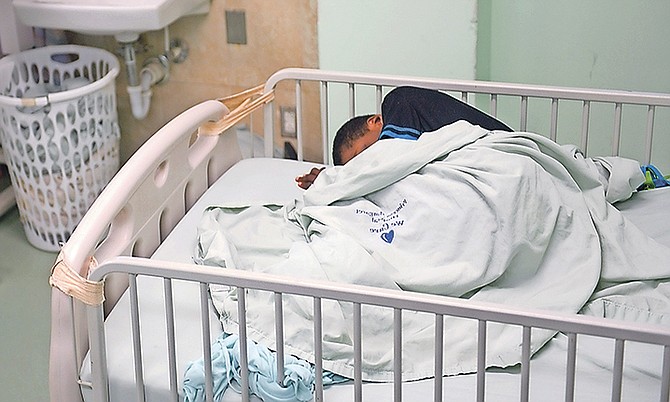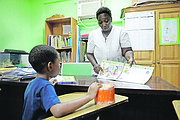By AVA TURNQUEST
Tribune Chief Reporter
aturnquest@tribunemedia.net
THOUSANDS of dollars spent daily at Princess Margaret Hospital to lodge homeless patients exposes an historic gap in the country’s ability to adequately care for its citizens in the face of rising demands for public health care, The Tribune has learned.
With 28 boarders presently costing the public hospital more than $15,000 a day, officials are calling for a national discussion and asking the public to take a long hard look at the current roles of the institution and the community.
Several current boarders have been at the hospital for as long as five years; however nursing staff provided several accounts of persons that were interned as infants and left as teenagers.
It is a phenomenon that also calls into question the efficacy of state-run social services, which work closely with the hospital to manage cases but are largely unsuccessful.
“This topic is a controversial topic,” Principal Nursing Officer Valerie Miller told The Tribune last week.
“It’s not one that the public is keen on hearing because it casts some aspersions on them to some extent, but PMH is really plagued by what we deem boarders. Boarders in our setting are those persons who would have come in to seek medical attention, and at the completion of their treatment the physician deemed it was fit for them to return home.
“These persons would not have been collected and discharged and hence they remain with us and we refer to them as boarders. Many of them are not on treatment and some of them are like many persons who take tablets at home every day so just taking medication is no indication to be in hospital. We have borders ranging from one-month-old to 84 years.”
She added: “This would be something that’s in the society and the society has changed and some persons truly have nowhere to go. We always do our assessment, a complete physical assessment and history taken on the patient, and sometimes you have your antennas going up at the very beginning that this is a potential problem.
Arthur, the boy living in the paediatric ward - full story HERE
“In a case like that we involve the social workers right away who can do their assessment, do a home assessment, and sometimes they realise that this is someone who we have to find an arrangement for. There are only so many places out there so they don’t have a high percentage of success rate for getting our patients out.”
Nurse Miller spoke to The Tribune during its investigation into reports that there were several young children who were living at the hospital indefinitely. Presently there are four children: two infants, a five-year-old, and an 11-year-old.
Some 15 years ago, the hospital utilised a school bus to take school-aged boarders to and from school; nowadays, Nurse Miller said there is a trained teacher onsite to ensure that children are able to keep up with curriculum while receiving long-term treatment.
However, she told The Tribune that there has been no change in how boarders are managed by the state since then.
“It’s the same challenges (for kids),” she said. “It’s harder. It took us years to get them (teenagers) out and they were here with us since they were babies. There are several things that contribute to that, while we have our challenges, I’m sure our sister institution has their challenges as well. And there are only so many persons they can accommodate in the ward (at Sandilands Rehabilitation Centre) designated for those type patients. But I can’t say it’s easier getting them out.”
While cases vary, a considerable number of boarder children have mental disabilities or require specialised medical care. Special needs children are admitted to SRC’s Robert Smith Ward.
Cost factor
A cost analysis undertaken by the hospital estimated that having two boarders in the Paediatric Ward cost the institution $1,108 per day; while a sample of 23 adult boarders cost the hospital $15,000 per day, Nurse Miller said.
The remaining boarders consist of 18 men, and six women, three of whom are non-nationals.
“Accommodating that number of persons who really don’t need to be in an acute setting,” Nurse Miller said, “not only is it dangerous, it compromises what you can do for someone who really needs acute care.”
“It’s very costly to have persons using an acute care bed in hospital. What it does, it lends to overcrowding, it’s very expensive because you now aren’t just having them in a bed but you have trained staff manage them whose services and skill set could be used on more acute patients. And there is, of course, lodging and utilities and feeding and clothing, everything.”
In June, Health Minister Dr Duane Sands told parliamentarians that the country had the highest incidence of diabetes in the world. With statistics depicting 79.2 per cent of the population diagnosed as obese or overweight, the steady rise in noncommunicable diseases has been an impossible phenomenon to ignore for public health care providers.
Notwithstanding sickness, Dr Sands further reported that the Accident and Emergency (A & E) Department at PMH managed 1,272 assaults, 246 stabbings and 216 gunshot wounds last year.
On Thursday, Nurse Miller surmised that the rising demand for state health services was bolstered by socioeconomic challenges.
“I think as a country, as a nation,” she said, “there is an increase in noncommunicable diseases, diabetics, hypertension, things like that are prevalent in our society and we see the effects of that.
“I also think there is an increase because as you speak to individuals they share that they would have lost insurances, lost jobs, so they would have normally tapped into the private sector but now they’re utilising hospital services as a public patient. It’s a combination of factors why the numbers are rising,” she said.
“When they come, one of the things we can do is do the full assessment and make the necessary referrals. You try to be proactive and don’t wait until the persons is discharged and then you find out there is nowhere to go.”
In July, a series of weekend challenges forced some A&E patients at the Princess Margaret Hospital to wait for more than 24 hours to receive treatment or be relocated to outpatient clinics due to malfunctioning equipment and severe overcrowding.
Dr Sands told The Tribune at that time, “There was just no room.”
“Just imagine 28 beds are taken that could be used,” Nurse Miller continued.
“Sometimes we have as many as 30 patients in the A&E awaiting admission but there are no beds. What it forces us to do is use trolleys which is not conducive for acutely ill patients and in extreme cases we also have to open additional wards which we refer to as virtual wards, areas that were decanted as part of our redevelopment.”
One such area was the space formerly used for the hospital’s General Practice Clinic, which is now located offsite. Virtual wards are usually staffed on an overtime basis, she said, as nurses currently on shift are attached to the established wards.
“When we open these various wards, they are acute care type patients with no acute care beds available so we still need to put that particular skill set in that environment on an overtime basis, and overtime adds up.
“It’s also difficult because overtime is optional so not every time you say you need a nurse that nurses are available so it can become challenging sometimes and it’s a significant cost.”
In August, Dr Sands put the cost of boarders - which he estimated to be around 30 persons - at more than $7m a year. He suggested that there should be a long-term or chronic care facility to accommodate these persons, telling The Tribune that the government was looking into partnering with a long-term facility to provide care for patients who cannot go to a regular nursing home due to psychical and mental challenges.
“It’s a sensitive thing,” Nurse Miller said.
“I’m not in the position to say who can take and who can’t take, but suffice to say we do have borders who have visitors. So clearly they are not alone, but they’re here so that suggests something. I’m not here to judge why because persons have their own stories and we’re not here to say why or who should or who can, that’s not for us to do.
“Personally, I do feel that as a country perhaps there needs to be some alternative plan. Some of these persons have old age pension, every little bit counts and helps,” she added.






Comments
tell_it_like_it_is 6 years, 7 months ago
This needs to be resolved posthaste. I don't understand families leaving babies and children? How cruel!
birdiestrachan 6 years, 7 months ago
Is there no space at the children's home or the old folks home so that they can go to these places instead of the hospital. I am sorry to learn that this situation exist.
ThisIsOurs 6 years, 7 months ago
They could be adopted, but no one has. It's not so simple. On a purely clinical analysis they have preexisting conditions which means they most likely can't get insurance. They have medical issues which means lots of doctors visits. (I'm generalizing). Time and money that many people don't have. If they could go to the children's home, I suspect they'd be there. If the parents left them at the hospital, I'd say they're better off than being with the parents. Like they imply in the story, it's a complicated issue.
Sign in to comment
Or login with:
OpenID